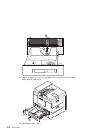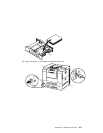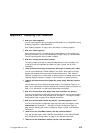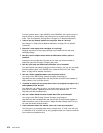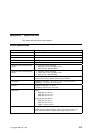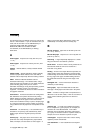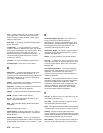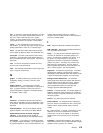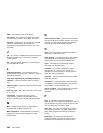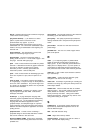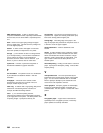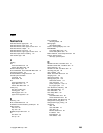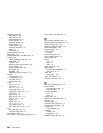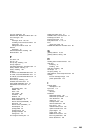coax. A cable consisting of one conductor, usually a
small copper tube or wire, within and insulated from
another conductor of larger diameter, usually copper
tubing or copper braid.
code page. A font library of hexadecimal identifiers to
graphic characters.
configuration. (1) The arrangement of a computer
system or network as defined by the nature, the number,
and the chief characteristics of its functional units. More
specifically, the term configuration may refer to a
hardware configuration or a software configuration. (2)
The devices and programs that make up a system,
subsystem, or network.
connector. A means of establishing electrical flow.
cut-sheet paper. Paper that is cut into sheets.
D
data stream. (1) All data transmitted through a data
channel in a single read or write operation. (2) A
continuous stream of data elements being transmitted, or
intended for transmission, in character or binary-digit
form, using a defined format.
default. An alternative value, attribute, or option that is
assumed when none has been specified.
diagnostic. Pertaining to the detection and isolation of
errors in programs and faults in equipment.
disable. To make non-functional. Contrast with enable.
DRAM. Dynamic random-access memory.
dry ink. The material that forms the image on the
paper. Synonymous with toner.
DSC. 3270 Information Display System data-stream
compatibility.
DSE. data switching exchange.
duplex printing. Printing on both sides of a sheet of
paper. Synonym for two-sided printing. Contrast with
simplex printing.
dotted decimal notation. A form of an IP address in
which each byte is represented as numbers, with periods
placed between the numbers such as 123.233.111. 222.
E
electrophotographic process. The creation of an
image on forms by uniformly charging the
photoconductor, creating an electrostatic image on the
photoconductor, attracting negatively charged toner to
the discharged areas of the photoconductor, and
transferring and fusing the toner to forms.
electrostatic image. The invisible image consisting of
discharged areas of the photoconductor as a result of
exposure from digital data.
enable. To make functional. Contrast with disable.
error log. (1) A data set or file in a product or system
where error information is stored for later access. (2) A
record of machine checks, device errors, and volume
statistical data.
error-recovery procedure. Procedures designed to
help isolate and, where possible, to recover errors in
equipment. The procedures are often used in
conjunction with programs that record the statistics of
machine malfunctions.
Ethernet. A 10-megabit baseband local area network
that allows multiple stations to access the transmission
medium at will without prior coordination, avoids
contention by using carrier sense and deference, and
resolves contention by using collision detection and
transmission. Ethernet uses carrier sense multiple
access with collision detection (CSMA/CD).
F
face Up. As paper is sent to an output bin or tray, the
printed side is placed face up.
face down. As paper is sent to an output bin or tray,
the printed side is placed face down.
FGID. Font Typeface Global Identifier. Used with IPDS
to identify fonts, such as FGID 416, which is Courier 10.
flushing. Process of removing data from printer
memory. Flushing is a message displayed on the printer
operator panel to indicate that a PCL or PostScript job is
being cancelled (removed from print memory).
flash memory. A type of random-access storage that
preserves its contents when power is removed from it.
278 User's Guide



